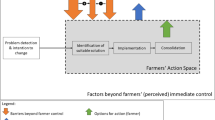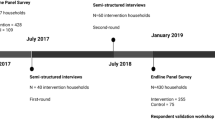Abstract
It is important to understandfactors that influence management decisionsthat determine the level of diversificationwithin cropping systems. Because of the widevariety of cropping systems within a region,our study focused on a single county (Marshall)in northwestern Minnesota. This county wasselected because it is in an area where farmerswere reevaluating their cropping practicesduring the 1990s in response to severe plantdisease outbreaks and economic stresses. Asurvey (n = 153) and follow-up interviews (n = 9)of representative farmers in Marshall Countyshowed that they were approaching theircropping systems management decisions underthese conditions through a dominant conceptualframework (scientific) and two secondaryconceptual frameworks (institutional andspiritual), which we termed “mental causalmodels.” The study illustrates the ways farmersdefine and make decisions affecting theircropping systems diversity under conditions ofagronomic and economic adversity. It alsochallenges agricultural professionals to expandtheir thinking about educational strategiesthat are sensitive to the varied perspectivesof farmers beyond just the scientific mentalcausal model.
Similar content being viewed by others
References
Abaidoo, S. and H. Dickinson (2002). “Alternative and conventional agricultural paradigms: Evidence from farming in Southwest Saskatchewan.” Rural Sociology 67: 114–131.
Allen, J. C. and K. Bernhardt (1995). “Farming practices and adherence to an alternative agricultural paradigm.” Rural Sociology 60: 297–309.
Allmaras, R., S. Copeland, J. Power, and D. Tanaka (1994). “Conservation tillage systems in the northernmost central United States.” In M. Carter (ed.), Conservation Tillage in Temperate Agroecosystems (pp. 99–158). Ann Arbor, Michigan: Lewis Publishers.
Alston, D. G. and M. E. Reding (1998). “Factors influencing adoption and educational outreach of integrated pest management.” Journal of Extension 36: 3 (http://www.joe.org/ joe/1998june/a3.html).
Anosike, N. and C. M. Coughenour (1990). “The socioeconomic basis of farm enterprise diversification decisions.” Rural Sociology 55: 1–24.
Battershill, M. R. and A. W. Gilg (1997). “Socio-economic constraints and environmentally friendly farming in the southwest of England.” Journal of Rural Studies 13: 213–228.
Bellon, M. (1996). “The dynamics of crop infraspecific diversity: A conceptual framework at the farmer level.” Economic Botany 50: 26–39.
Beus, C. E. and R. E. Dunlap (1990). “Conventional versus alternative agriculture: The paradigmatic roots of the debate.” Rural Sociology 55: 590–616.
Beus, C. E. and R. E. Dunlap (1991). “Measuring adherence to alternative vs. conventional agricultural paradigms: A proposed scale.” Rural Sociology 56: 432–460.
Beus, C. E. and R. E. Dunlap (1994). “Agricultural paradigms and the practice of agriculture.” Rural Sociology 59: 620–635.
Burkhart, M. R., S. L. Oberle, M. J. Hewitt, and J. Pickus (1994). “A framework for regional agroecosystem characterization using the National Resources Inventory.” Journal of Environmental Quality 23: 866–874.
CAST (1999). Benefits of Biodiversity Report. Ames, Iowa: Council for Agricultural Science and Technology (http:// www.cast-science.org/biod/ biod_ch.htm.).
Chiappe, M. B. and C. B. Flora (1998). “Gendered elements of the sustainable agriculture paradigm.” Rural Sociology 63: 372–393.
Cruse, R. M. and D. L. Dinnes (1995). “Spatial and temporal diversity in production fields.” In R. K. Olson, C. A. Francis, and S. Kafka (eds.), Exploring the Role of Diversity in Sustainable Agriculture (pp. 73–94). Madison, Wisconsin: American Society of Agronomy.
Cutforth, L. B. (1999). Social, Economic, and Environmental Factors Affecting Crop Diversity. Masters Thesis. Lincoln, Nebraska: University of Nebraska.
DeVore, B. (1998). “Biodiversity and agriculture: A house divided.” The Land Stewardship Letter 16(5): 1-7.
Dillman, D. (1978). Mail and Telephone Surveys: The Total Design Method. New York: Wiley Press.
Duram, L. A. (1998). “Taking a pragmatic behavioral approach to alternative agriculture research.” American Journal of Alternative Agriculture 14: 2–10.
Halliday, J. (1989). “Attitudes towards farm diversification: Results from a survey of Devon farms.” Journal of Agricultural Economics 40: 93–100.
Ibery, B. (1991). “Farm diversification as an adjustment strategy on the urban fringe of the West Midlands.” Journal of Rural Studies 7: 207–218.
Jackson-Smith, D. and F. Buttel (1998). “The conventional-alternative agricultural paradigm: A replication.” Paper prepared for the Rural Sociological Society Meeting, Portland, Oregon.
Jimmerson, R. M. (1989). “What values will guide extension's future?” Journal of Extension 27: 3 (http://www.joe.org/joe/ 1989fall/a5.html).
Karlen, D. L., G. E. Varvel, D. E. Bullock, and R. M. Cruse (1994). “Crop rotations for the 21st century.” Advances in Agronomy 53: 1–45.
Lyson, T. and R. Welsh (1993). “The production function, crop diversity, and the debate between conventional and sustainable agriculture.” Rural Sociology 58: 424–439.
Matson, P.A.,W. J. Parton, A. G. Power, and M. J. Swift (1997). “Agricultural intensification and ecosystem properties.” Science 277: 504–509.
McMullen, M., R. Jones, and D. Gallenburg (1997). “Scab of wheat and barley: A re-emerging disease of devastating impact.” Plant Disease 81: 1340–1347.
Merriam, S. B. (1998). Qualitative Research and Case Study Applications in Education. San Francisco, California: Jossey-Bass.
Miles, M. and A. Huberman (1994). Qualitative Data Analysis. Thousand Oaks, California: Sage.
Miller, A. (1984). “Psychosocial origins of conflict over pest control strategies.” Agriculture, Ecosystems and Environment 12: 235–251.
Patterson, T. E. (1993). “Paradigms for program planning.” Journal of Extension 31: 2 (http://www.joe.org/1993summer/ a7.html).
Petrzelka, P., P. Korsching, and J. Malia (1996). “Farmers' attitudes and behavior toward sustainable agriculture.” Journal of Environmental Education 28: 38–44.
Pope, R. D. and R. Prescott (1980). “Diversification in relation to farm size and other socioeconomic characteristics.” American Journal of Agricultural Economics 62: 555–559.
Raedeke, A. H. and J. S. Rikoon (1997). “Temporal and spatial dimensions of knowledge: Implications for sustainable agriculture.” Agriculture and Human Values 14: 145–158.
Sabatier, P. I. A. and H. C. Jenkins-Smith (1993). Policy Change and Learning: An Advocacy Coalition Approach. Boulder, Colorado: Westview Press.
Sternberg, B. Von. (1999). “Freedom to farm or fail?” Minneapolis Star-Tribune, September 5 (http://www.startribune.com).
Swaffield, S. (1998). “Frames of reference: A metaphor for analyzing and interpreting attitudes of environmental policy makers and policy influencers.” Environmental Management 22: 495–504.
Tuxill, J. (1999). “Nature's cornucopia: Our stake in plant diversity.” Worldwatch Paper 148. Washington, DC: Worldwatch Institute.
United States Census Bureau (2000). State and County Quick Facts. Marshall County, Minnesota. Washington, DC: U.S. Census Bureau (http://quickfacts.census.gov/qfd/state/ 27/27089.html).
United States Department of Agriculture (1997). Census of Agriculture - County Profile. St. Paul, Minnesota: Minnesota Department of Agriculture Statistics Service.
Author information
Authors and Affiliations
Corresponding author
Rights and permissions
About this article
Cite this article
Corselius, K.L., Simmons, S.R. & Flora, C.B. Farmer perspectives on cropping systems diversification in northwestern Minnesota. Agriculture and Human Values 20, 371–383 (2003). https://doi.org/10.1023/B:AHUM.0000005148.00229.70
Issue Date:
DOI: https://doi.org/10.1023/B:AHUM.0000005148.00229.70




